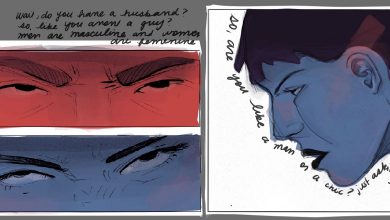Feminism 101: What is Intersectional Feminism?

Design by Laura Yau.
Women do not make 78 cents to a man’s dollar.
According to a study by the American Association of University Women, Hispanic or Latina women make 54%, Native American and Alaska Native women make 59%,Pacific Islander women make 62%, and African American women make 63% of what a white man makes. The only group that did better than white women (at 78%) was Asian American women who make 90% of what a white man makes. Women with disabilities make 65% of what men without disabilities make. Trans women are paid almost a third less after they transition.
The fact that the 78 cents statistic is so widespread is indicative of a much larger issue: feminism too often ignores people of color, people with disabilities, and transgender people.
That kind of feminism is called white feminism, which assumes all women experience misogyny the same way. But if you look at the real statistics behind the wage gap, it’s easy to see that’s not true.
Intersectional feminism, on the other hand, is a form of feminism that aims to include all women and recognize that race, gender identity, sexual orientation, ability, and class all influence how much and in what ways women are oppressed.
Intersectional feminism came from black feminism, a movement that included figures such as Audre Lorde and bell hooks, and that was born out of the racism of the Women’s Movement and the sexism of the Civil Rights Movement. Many of these women split from “mainstream” women’s liberation to form organizations that reflected the vision they had for their own liberation.
These organizations included the Combahee River Collective, a black feminist lesbian organization. One of their key contributions to feminism was the Combahee River Collective Statement, which described black feminism and declared a commitment to fighting “racial, sexual, heterosexual, and class oppression.” They saw black feminism as “the logical political movement to combat the the manifold and simultaneous oppressions that all women of color face,” a mindset that can today be applied to intersectionality.
Intersectionality as a term was coined by Kimberlé Crenshaw in 1989. Crenshaw, a law professor at UCLA and Columbia, saw black women as being “legally invisible”: the legal system saw sexism as being injustice to all women and racism as being injustice to all people of color. It ignored the unique position of those who faced both.
Intersectionality was originally intended to create a space where black women could be both black and women without having either of those identities devalued. But, in Crenshaw’s words, “intersectional erasures are not exclusive to black women.” Today, intersectionality can be used to understand groups that are ignored in various movements, such as people of color in the LGBTQIA+ rights movement, trans women in the feminist movement, and people with disabilities fighting police brutality.
Though intersectionality was conceptualized over twenty-five years ago, many of today’s feminist icons still have a long way to go.
Take, for example, Taylor Swift, whose feminism seems to be restricted to white, conventionally attractive, middle-class women. Swift appropriates with reckless abandon then undermines black women for expressing frustration over their lack of recognition.
Hillary Clinton, as the most famous (but not only) female presidential candidate this election, is often lauded as a feminist icon. But what kind of feminist icon supports Western imperialism, serves on the board of Walmart which fails to pay employees a living wage, and has supported various bills that target poor African Americans? A white feminist icon, that’s what.
Fortunately for us, though, there are many feminists in the public eye who use an intersectional approach to countering oppression.
Intersectionality has a huge presence online. Franchesca Ramsey and Akilah Hughes are just two of a large community of Youtubers and bloggers who write about and post videos on feminism, race, and intersectionality. Being young and active on the internet, they help to put intersectionality, a complex concept with a lot of academic baggage, in terms anyone can understand. In Akilah Hughes’s words, “We need to be talking about pizzas who are sexually attracted to other pizzas, pizzas who aren’t sexually attracted to anything, pizzas who identify as burgers, and pizzas with different toppings, because as great as it is to uplift cheese pizzas, the world could use a lot more flavor.”
Writers like Roxane Gay, author of the essay collection “Bad Feminist,” have also been a voice for intersectional feminism. In a conversation with novelist and second-wave feminist Erica Jong, Gay brought attention to the importance of intersectionality, saying, “We have to realise that just because we’re women doesn’t mean we’re equal.”
Some celebrities are also incorporating intersectionality into their feminism and activism. Actress Rosario Dawson has championed the rights of girls of color by working with organizations like the Lower Eastside Girls Club. She also founded Voto Latino, an organization that “empower[s] Latinos to be agents of change.”
It’s impossible to separate women’s issues from race , class, sexuality, and ability. To try and separate them is to claim that one is more important than the others and that they act independently. But the reality is that all of these issues interact and influence each other all the time.
It would be simple if all women regardless of race, class, or ability were paid 78 cents to a man’s dollar. Intersectionality is about recognizing it’s not that simple. Patterns of oppression are all connected and realizing that is the first step to make the world a little more equal for all of us.




